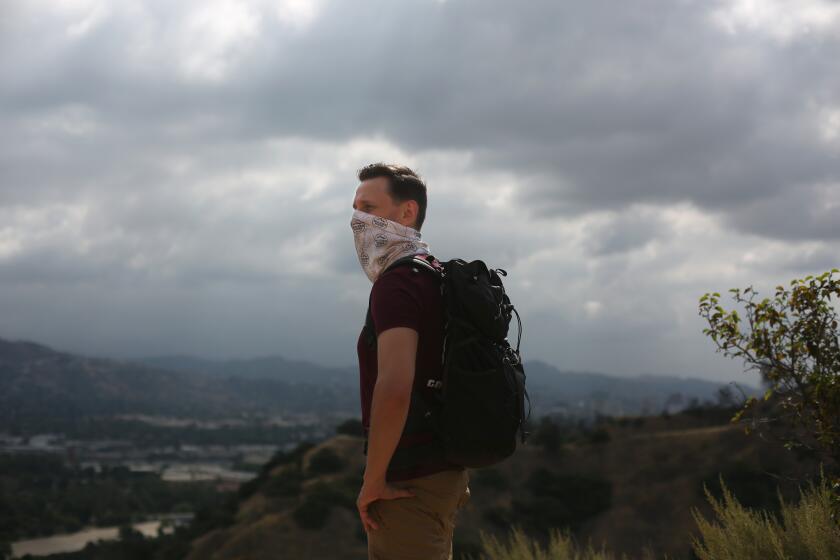A forgotten titan of New York, revived in fiction
- Share via
On the Shelf
The Great Mistake
By Jonathan Lee
Knopf: 304 pages, $27
If you buy books linked on our site, The Times may earn a commission from Bookshop.org, whose fees support independent bookstores.
Should you immediately recognize the name Andrew Haswell Green, the historic civic leader and protagonist of Jonathan Lee’s new novel “The Great Mistake,” perhaps it’s because of the New York City institutions he founded, which astoundingly include Central Park, the New York Public Library, the Metropolitan Museum of Art, the Museum of Natural History and the Bronx Zoo. He is even, arguably, responsible for uniting the city’s five boroughs. But more likely you haven’t heard his name at all. Despite his tireless work for the city he moved to in 1835, Green didn’t seek laurels.
“The Great Mistake” speculates one reason for that: Lee’s fictionalized version of Green is a gay man whose anxieties about his education and social class tangle so tightly with his sexual orientation and personal ambition that it’s a wonder he manages to accomplish anything at all.
After earning a law degree with the support of his friend Samuel Tilden, Green was elected to the New York City School Board, then led the Central Park Commission and managed the establishment of some of the city’s foundational institutions. But his greatest contribution to New York may have been his opposition to Boss Tweed’s corrupt machine, which culminated in Tilden’s election as New York State governor and Green’s appointment as city comptroller.
Non-spoiler alert: Green dies on page three, shot in front of his Park Avenue townhouse by a Black man named Cornelius Williams. Lee has structured his novel on two timelines: The first tracks the investigation into Green’s 1903 shooting; the second flashes back to his childhood and follows him up to his death.
This structure naturally lends itself to suspense, which Lee knows how to exploit. In his audacious and assured 2016 U.S. debut, “High Dive,” Lee took another historical event — the 1984 planting of a bomb in a Brighton hotel in advance of Margaret Thatcher’s arrival — and spun out its effects on the characters involved. Here, readers are kept guessing at Williams’ motive for the shooting.
Anderson needed to understand the former British Prime Minister to play her in “The Crown.” But she knows she’s unlikely to assuage Thatcher’s critics.
Lee elevates the tidy historical mystery plot by allowing readers to understand that, despite his own marginalized status as a gay man, Green was able to rise through his privileged status as a white man in the same society that made life difficult for the Black man who shot him, the Irish woman who keeps his house and the woman of mixed race whose luxurious brothel the shooter craves.
At an early low point in Green’s trajectory, when he believes “His city adventure had failed,” he gets the chance to spend a year managing a Trinidadian sugar plantation. While Lee doesn’t overlook the abuses of those plantations (Green kept a detailed diary from that year), his purpose is to investigate what might have transformed Green into a man of sophistication and action. Intriguingly, it has little to do with intimacy. He does experience a great love, but cannot make that romance public — not in a rowdy, 19th-century New York City where pigs roam the streets and bounty hunters stalk stray dogs.
Make no mistake about “The Great Mistake”: Lee isn’t writing a novel about race per se, or even about inequality. His title refers to Green’s murder as well as his union of Brooklyn and Queens with Manhattan, “The Great Mistake of 1898”— but it also reminds us the greatest mistake (or maybe misfortune) is to live without love.
We meet Green as a child whose depressed mother and rigid father exhibit no affection at all; as an adolescent whose feelings for his best friend are nipped in the bud; as a young man who allows Tilden to break his heart; and as a man of vigorous middle age who occasionally lies beside Tilden in bed. It’s a remarkable and subtle portrait of a person forced to redirect his life’s energies, channeling them into projects that still change other people’s lives a century and a half later.
Late in his novel, “Real Life,” Brandon Taylor breached the scrim between himself and what he wanted to describe. In “Filthy Animals,” there is no scrim.
Lee’s sentences and scenes are so polished and vivid, they can almost be read as separate set pieces: The farm scenes, Green’s work for a Manhattan dry goods store, the Trinidadian year, the introductions to society and so on — up to Inspector McCluskey’s investigations at the aforementioned brothel. But the effect of the writing is cumulative — a construction in which we come to understand that every great mistake is made up of smaller ones. Call it Lee’s version of “for the want of a nail, the war was lost.”
Or, conversely, every great success depends on many helping hands. Toward the book’s end, Green recalls a kindness from the grocer who employed him. He’s talking to his portraitist, but we only learn the full story in Green’s mind; Hinsdale the grocer, on hearing that Green plans to leave and take another job, “kissed him on the cheek, the edge of his lips, and said: Good boy. I am proud, Finally, you are becoming you.
“And it had meant everything. It had been like having, for a moment, another father.”
And so Lee, a 40-something writer from Great Britain, brings back to life an 80-something titan of New York City — neither to bury nor to praise him, but to allow Andrew Haswell Green an authentic existence he never had. Today, Green’s only memorials are a hidden bench in Central Park and that portrait, even more deeply hidden in Manhattan’s City Hall. Lee has given his subject a prose memorial with a beating heart and superb mind, something worthy at last of a complicated man whose vision far exceeded his fame.
“Discovering Griffith Park,” a history-rich guidebook by Casey Schreiner, gives one of the country’s largest, greatest city parks its due.
Patrick is a freelance critic who tweets @TheBookMaven.
More to Read
Sign up for our Book Club newsletter
Get the latest news, events and more from the Los Angeles Times Book Club, and help us get L.A. reading and talking.
You may occasionally receive promotional content from the Los Angeles Times.












